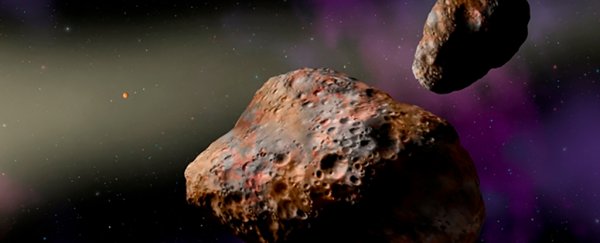A new study of the binary asteroid Patroclus-Menoetius has revealed some clues about the chaotic and turbulent beginnings of our Solar System – primarily when Uranus and Neptune were bullied away from the Sun by Jupiter and Saturn.
The pair of asteroids, both a little over 100 km (62 miles) in diameter, are part of the mass of objects that make up the Jupiter trojan belt, circling the Sun at similar distances as Jupiter.
It's thought that this band of debris was created as the Solar System's biggest planets jostled for position, but the big question is: when did all this happen?
According to this new study, it all went down in the first 100 million years of the Solar System's existence, says the team from the Southwest Research Institute in Colorado. Otherwise, Patroclus and Menoetius wouldn't be where they are, the only large binary pair in the Jupiter trojans.
"The Trojans were likely captured during a dramatic period of dynamic instability when a skirmish between the Solar System's giant planets – Jupiter, Saturn, Uranus and Neptune – occurred," says one of the team, David Nesvorny.
This period of stability pushed Uranus and Neptune out towards a mass of primordial bodies thought to now exist as the Kuiper Belt. In turn, some of these bodies would have been pushed inwards and caught in the Jupiter trojans, the researchers say.
Based on observations of Patroclus-Menoetius, and recent models of small object formation in the Solar System, the team thinks the planetary shake-up must've happened early on – otherwise no binary asteroids would have survived the chaos.
Had the rearrangement of Jupiter, Saturn, Uranus and Neptune happened millions of years later – as some Solar System models suggest – the fragile balance between these two unusual asteroids would have been destroyed by collisions inside the disk that went on to create the Kuiper Belt, the study shows.
 Artist's impression of the Trojan asteroids. (NASA/JPL-Caltech)
Artist's impression of the Trojan asteroids. (NASA/JPL-Caltech)
"Observations of today's Kuiper Belt show that binaries like these were quite common in ancient times," says one of the researchers, William Bottke. "Only a few of them now exist within the orbit of Neptune. The question is how to interpret the survivors."
If the researchers are right, it could have implications for other aspects of Solar System history, like the collisions that hit the Moon as part of the Late Heavy Bombardment event around 4 billion years ago.
The presence of Patroclus-Menoetius suggests these collisions might well have been the work of the remnants of planets close to the centre of the Solar System, rather than objects travelling in from further away.
We'll need to know more about Patroclus and Menoetius to be sure, and that's one of the reasons why NASA is launching the Lucy probe in October 2021. Lucy will be visiting several asteroids, including Patroclus-Menoetius.
Peering back billions of years into the past isn't easy, but Patroclus-Menoetius shows that the Solar System hides a wealth of clues about its origins – it's just a question of joining together the dots. And sometimes the smallest dots can tell us about the biggest planets.
"The longer the [Patroclus-Menoetius] binary stayed in the disk, the greater the likelihood that collisions would strip its components from one another," conclude the researchers.
"The simulations of its survival indicate that the disk had to have been dispersed by migrating planets within 100 million years."
The research has been published in Nature Astronomy.
